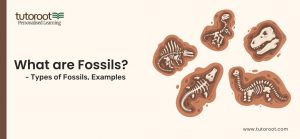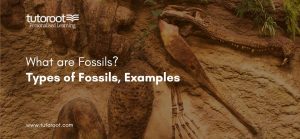What are Fossils? – Types of Fossils, Examples
Introduction
Fossils are the preserved remains, impressions, or traces of ancient organisms that lived millions of years ago. They provide us with invaluable insights into the history of life on Earth, offering a glimpse into the past environments and ecosystems that once existed. Fossils are not just limited to bones; they can include footprints, leaf imprints, shells, and even entire organisms preserved in amber. This article explores the fascinating world of fossils, covering their types, examples, and how they were formed.
What are Fossils?
Fossils are physical evidence of organisms that lived in the distant past. They are typically formed when plants, animals, or other organisms are buried under sediment and subjected to pressure over time. The process of fossilization preserves the organism’s remains, which can include bones, shells, and even traces like footprints. Fossils are crucial for understanding the evolutionary history of life on Earth, providing evidence of species that are long extinct and helping scientists to reconstruct ancient environments.
Fossils are found in various forms, from the bones of dinosaurs to the imprints of ancient plants. The study of fossils, known as paleontology, involves the careful examination of these preserved remains to piece together the history of life on our planet. Fossils can be found in sedimentary rocks, formed by sediment accumulation in layers. Over time, the sediment hardens into rock, trapping the remains of organisms within it. These remains are then slowly replaced by minerals, turning them into fossils.
The significance of fossils cannot be overstated. They provide a record of life’s diversity and evolution, showing how species have changed and adapted over millions of years. Fossils also help scientists to understand the geological history of the Earth, revealing information about ancient climates, ecosystems, and the movement of continents.

Examples of Fossils
Fossils come in many forms, and each type provides unique information about the past. Some common examples of fossils include:
- Dinosaur Fossils: These are perhaps the most famous fossils, including the bones and teeth of giant reptiles that roamed the Earth millions of years ago. Dinosaur fossils have been found all over the world, providing insight into their size, diet, and behavior.
- Ammonite Fossils: Ammonites were marine mollusks with spiral shells, and their fossils are commonly found in sedimentary rocks. These fossils are often used as index fossils to date the age of rock layers.
- Plant Fossils: Fossilized leaves, seeds, and even entire trees have been found, offering a glimpse into the vegetation that existed millions of years ago. These fossils help scientists understand ancient climates and ecosystems.
- Insect Fossils in Amber: Amber, fossilized tree resin, sometimes contains trapped insects that are perfectly preserved. These fossils provide detailed information about ancient ecosystems.
How Fossils Were Formed?
The formation of fossils is a complex process that requires specific conditions to preserve the remains of organisms. Fossils are typically formed through a process called fossilization, which can occur in several ways. Here’s a detailed look at how fossils are formed:
- Death and Burial: The first step in fossil formation is the death of an organism. For fossilization to occur, the remains of the organism must be quickly buried under sediment. This sediment could be sand, mud, or volcanic ash, which protects the remains from scavengers and slows down the decomposition process.
- Sediment Accumulation: Over time, more sediment accumulates on top of the buried remains, compressing the layers beneath it. This pressure helps to preserve the remains, as the sediment turns into rock.
- Mineral Replacement: As the remains are buried deeper, groundwater rich in minerals seeps into the bones or shells. These minerals slowly replace the organic material, turning the remains into stone. This process is known as permineralization.
- Mold and Cast Formation: Sometimes, the remains of the organism dissolve, leaving behind a mold in the surrounding rock. If minerals fill this mold, a cast fossil is formed. These fossils provide a three-dimensional representation of the organism.
- Carbonization: In some cases, the organic material of the organism is reduced to a carbon residue, leaving a detailed imprint of the organism in the rock. This process is common for plant fossils.
- Impressions and Trace Fossils: Not all fossils are formed from the remains of organisms. Some fossils, known as trace fossils, are formed from the imprints or tracks left by organisms. These include footprints, burrows, and even droppings.
What is Taphonomy?
Taphonomy involves studying the processes through which organisms decompose and become preserved as fossils. It involves understanding the processes that occur from the time of death to the eventual preservation of the remains as fossils. Taphonomy helps paleontologists to interpret the fossil record by analyzing the factors that influence fossilization, such as environmental conditions, the presence of scavengers, and the type of sediment in which the remains are buried.
Types of Fossils
Fossils are classified into various types, each offering unique information about the history of life. The primary categories of fossils are:
- Body Fossils: These are the preserved remains of the actual body parts of organisms, such as bones, teeth, and shells. Body fossils are the most common type of fossil and provide direct evidence of the organism’s physical characteristics.
Example: Dinosaur bones are a classic example of body fossils. These fossils reveal the size, structure, and sometimes even the behavior of these ancient creatures.
- Trace Fossils: Also referred to as ichnofossils, these fossils capture evidence of an organism’s activities, such as footprints or burrows, rather than its physical form. This includes footprints, burrows, and even fossilized feces.
Example: Fossilized footprints of early humans or dinosaurs are examples of trace fossils. They provide insights into the behavior and movement of these organisms.
- Mold and Cast Fossils: Mold fossils are formed when an organism’s remains dissolve, leaving an impression in the surrounding rock. If this mold is later filled with minerals, a cast fossil is formed, creating a three-dimensional replica of the organism.
Example: Ammonite molds and casts are common examples. The original shell dissolves, but the mold and cast provide a detailed representation of its shape.
- Carbon Fossils: These fossils are formed when the organic material of an organism is reduced to a carbon residue, leaving a detailed outline of the organism in the rock. Carbon fossils are common for plants and soft-bodied organisms.
Example: Fossilized leaves and ferns often appear as dark imprints in rocks, providing detailed information about ancient vegetation.
Major Ways Organisms Turn into Fossils
Organisms can become fossils through several processes, each requiring specific conditions. Here are the major ways organisms turn into fossils:
- Permineralization: Minerals carried by water fill the spaces within organic tissue, preserving the structure of the organism.
- Natural Molds and Casts: The remains of the organism create a mold in the surrounding sediment, which can later be filled with minerals to form a cast.
- Amber Preservation: Organisms, particularly insects, become trapped in tree resin that hardens into amber, preserving them in remarkable detail.
- Freezing: In rare cases, organisms are preserved in ice or permafrost, preventing decomposition and preserving them almost intact.
- Carbonization: Organic material is compressed, leaving behind a carbon-rich film that preserves a detailed outline of the organism.
- Recrystallization: The original skeletal material of an organism changes at the molecular level, preserving its structure but altering its mineral composition.
- Impression Fossils: Organisms leave imprints in soft sediment that hardens into rock, preserving the shape and details of the organism.
Final Verdict
Fossils are invaluable windows into the past, revealing the history of life on Earth. From dinosaur bones to the fine impressions of prehistoric plants, fossils are vital for understanding evolutionary processes, ancient ecosystems, and the history of life. Understanding the different types of fossils and how they are formed enriches our knowledge of the natural world and the processes that have shaped our planet over millions of years.
If you’re looking to deepen your understanding of subjects like this, visit the Tutoroot Blog for more insightful content. Our Physics Online Tuition offer personalized support to help you grasp complex topics with ease. Ready to take your learning to the next level? Schedule a FREE DEMO session with Tutoroot’s online home tuition today and start mastering your subjects!
FAQs
Define fossils.
Fossils consist of preserved remnants, impressions, or marks left by organisms from ancient times.
What are 4 types of fossils?
The principal categories of fossils are body fossils, trace fossils, mold and cast fossils, and carbon fossils.
What is dinosaur fossils?
Dinosaur fossils refer to the preserved remains or traces of dinosaurs, including their bones, teeth, and footprints.
Name the types of fossils?
The types of fossils include body fossils, trace fossils, mold and cast fossils, and carbon fossils.
What is ammonite fossil?
An ammonite fossil is the preserved remains of an extinct marine mollusk with a spiral shell, commonly used as an index fossil to date rock layers.

